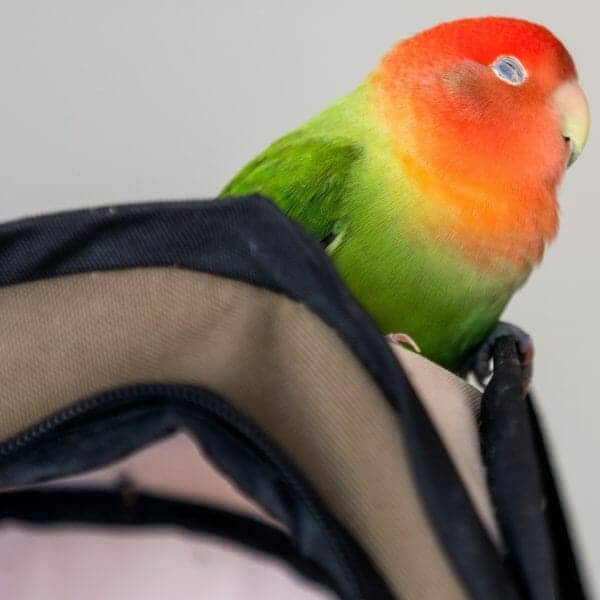Last Updated on by Mitch Rezman
How do we know parrots enjoy anything? Another question recently asked on Quora was “what do parrots do for fun”?
We know parrots prefer “working” for food versus simply eating from overflowing bowls of parrot food.
We know correlation does not necessarily imply causation but can we infer that work & play are one and the same for a parrot?
Entrepreneurs are far happier working for less money with no boss in the equation. I don’t see much of a difference.
Parrots figured out that fending for themselves was both fun and play while being a learning process.
They clearly know that “15 places to find food is better than 10 places to find food.”
“If I can reach 20 places to find food, I can make babies and feed them”.
If we could get into parrots’ heads, we wouldn’t have pluckers, screamers, and prolific egg layers. I’m certain humans are not smart enough to do so.
All we can do is guess.
To this question’s point – if you look at the 10,400 or so species of birds on the planet, most bird species are flock animals and those that don’t still have intra-species verbalization to communicate enormous amounts of valuable of information regarding food health and safety.
We know that cockatoos can make tools out of wood to help them obtain food. Magpies make tools out of metal wire to impale larva.
Crows create their own toys like sleds for sledding down steep roofs covered in snow. Finches and woodpeckers use twigs to impale larva.
Scrub Jays “recache” their food especially if they know other birds saw them hide it.
They will move the food after the other birds have left.
The ingenuity of birds is breathtaking
BUT….
This begs the question “what good is a stash of food if you can’t communicate to other flock members where you put it”?
In Australia, a flock of almost a million budgies communicate with scout parties that are sent off to find the best places for foraging grass seed and water.
Birds are always communicating. Many species can identify babies that are just a couple of days old by their “voice.”
It’s important to keep in mind that birds have three times the neurons as mammals with respect to brain size and process thought three times quicker than us terrestrial mammals.
A case could be made that birds are the first “organic” AI (Artificial Intelligence) because of how fast they process thought and make decisions.
How do hawks fly through a crowded forest at 40 MPH without constantly crashing into trees?
AI can not duplicate that thought process – yet.
I am advocating that when birds mimic, they are communicating. We know the work that Dr. Irene Pepperberg has done illustrates that birds are able to communicate “concepts.”
Mammalian infants don’t instinctively know what objects like a foot or a ball or a toy are, any more than parrots. Both species must learn.
Mimicking is part of a bird’s learning repertoire that because they are so smart they can’t help but avoid (this learning process).
The original question makes the assumption that a bird is mimicking a human. Is it because the bird repeats the word or the phrase a number of times?
When musicians “practice” they play the same music over and over to improve their performance because they learn it better.
Perhaps mimicking is a bird’s method of improving its own performance by repetition.
It (the bird) gets better at understanding the relationship between words and objects or concepts – or perhaps not.
Is a budgie in a crowded flock flying over the Australian outback is thinking…………………
“If that kangaroo is heading towards food, we’ll follow him because it’s more efficient than randomly searching for food”.
“I hope everyone in the flock is on the same play page – “chirp – chirp – chirp – squawk – squawk”.
The closest bird in the flock responds with – “chirp – chirp – chirp – squawk – squawk”.
The next closest bird shouts – “chirp – chirp – chirp – squawk – squawk”.
Are they mimicking – or are they communicating?
I suppose if we created a database with all the mimicry thousands of birds are performing while at the same time recording their actions, we somehow could learn how to associate their vocabulary with their body movements to better understand what they are really saying.
Birds have been around for 99 million years. If we follow through on my AI concept we may find that they’re actually speaking a language too complex for humans to comprehend.
Humans can’t leave the house without clothing from neck to foot, satchels with everything from sealed vessels of liquids, clothing changes, electronics, and snack bars should Armageddon befall them before getting to work.
For 99 million years birds of get by with nothing more than their feathers beak and feet.
If you want to believe that birds do nothing more than simply repeat random phrases, take a look at this video of Disco a budgie (recently passed) that truly “has a sense of his own identity”.
Written by Mitch Rezman
Approved by Catherine Tobsing
Author Profile
Latest entries
 The Traveling BirdJune 26, 2025Can You Name 5 Parrot Species That Are Living Wild in the USA?
The Traveling BirdJune 26, 2025Can You Name 5 Parrot Species That Are Living Wild in the USA? Bird BehaviorJune 26, 2025How is it Parrots Are Problem Solvers Social Animals and Even Use Tools?
Bird BehaviorJune 26, 2025How is it Parrots Are Problem Solvers Social Animals and Even Use Tools? Bird & Parrot AnatomyJune 25, 2025How a Tiny Chemical Modification Makes Parrots Nature’s Living Paintings
Bird & Parrot AnatomyJune 25, 2025How a Tiny Chemical Modification Makes Parrots Nature’s Living Paintings PigeonsJune 20, 2025How Do Parrots Thrive in Cities Outside Their Native Habitats?
PigeonsJune 20, 2025How Do Parrots Thrive in Cities Outside Their Native Habitats?




